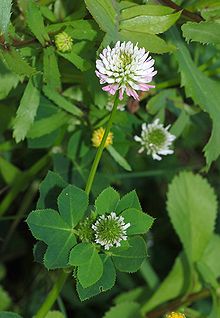- Trifolium repens
-
White clover 
Conservation status Scientific classification Kingdom: Plantae (unranked): Angiosperms (unranked): Eudicots (unranked): Rosids Order: Fabales Family: Fabaceae Subfamily: Faboideae Genus: Trifolium Species: T. repens Binomial name Trifolium repens
L.Trifolium repens, the white clover (also known as Dutch clover), is a species of clover native to Europe, North Africa, and West Asia. It has been widely introduced worldwide as a pasture crop, and is now also common in most grassy areas of North America and New Zealand.
Contents
Name
The genus name, Trifolium, derives from the Latin tres, "three", and folium, "leaf", so called from the characteristic form of the leaf, which has three leaflets (trifoliate); hence the popular name trefoil.
The species name, repens, is Latin for "creeping".
Growth
It is a herbaceous, perennial plant. It is low growing, with heads of whitish flowers, often with a tinge of pink or cream that may come on with the aging of the plant. The heads are generally 1.5–2 cm wide, and are at the end of 7 cm peduncles or flower stalks.[1] The leaves, which by themselves form the symbol known as shamrock, are trifoliolate, smooth, elliptic to egg-shaped and long-petioled. The stems function as stolons, so white clover often forms mats, with the stems creeping as much as 18 cm a year, and rooting at the nodes.[1]
Cultivation and uses
Companion planting
White clover grows among turfgrass, crops, and in a large number of other landscapes.[1] It is also found in a limited range of different field type environments. White clover can tolerate close mowing, and can grow on many different types and pHs of soil, but prefers clay.[1] It is considered to be a beneficial component of natural or organic lawn care due to its ability to fix nitrogen and out-compete lawn weeds. Natural nitrogen fixing reduces leaching from the soil and can reduce the incidence of some lawn diseases that are enhanced by the availability of synthetic fertilizer.[2]
Culinary uses
Besides making an excellent forage crop for livestock, clovers are a valuable survival food: they are high in proteins, widespread, and abundant. The fresh plants have been used for centuries as additives to salads and other meals consisting of leafy vegetables.
They are not easy for humans to digest raw, however, but this is easily fixed by boiling the harvested plants for 5–10 minutes.[3] Dried flowerheads and seedpods can also be ground up into a nutritious flour and mixed with other foods, or can be steeped into a tisane. White clover flour is sometimes sprinkled onto cooked foods such as boiled rice.
When used in soups, the leaves are often harvested before the plant flowers. The roots are also edible, although they are most often cooked firsthand.
Medicinal uses
White clover has been used as minor folk medicine by the Cherokee, Iroquois, Mohegan and other Native American tribes for centuries.
The Cherokee, for instance, used an infusion of the plant to treat fevers as well as Bright's disease. The Delaware and Algonkian natives used the same infusion, but as a treatment for coughing and the common cold.[citation needed]
As an invasive weed
Before the introduction of broad-leaf herbicides, white clover was more often added to lawn seed mixes than it is today, as it is able to grow and provide green cover in poorer soils where turfgrasses do not perform well. Many people consider clover a weed when growing in lawns, in part because the flowers are attractive to bees and thus could create a danger for people with bare feet.
White clover is the only known plant on which the caterpillars of the Coleophoridae case-bearer moth Coleophora mayrella feed.[citation needed]
In Britain, a high abundance of white clover is generally associated with species-poor, agriculturally improved grassland habitats, as it outcompetes the more rare plants and grasses especially in fertile soils, and has often been added as part of reseeding. Agri-environment schemes, such as the Countryside Stewardship Scheme, Environmentally Sensitive Areas Scheme, and Environmental Stewardship, give funding to species-rich grasslands that are relatively infertile and do not generally have an abundance of white clover. However, white clover does have value as a pollen and nectar source particularly in intensively farmed areas or amenity grasslands where there are few other flowers, and it can be found naturally at low levels in species-rich grasslands.[citation needed].
References
- ^ a b c d Richard H. Uva, Joseph C. Neal and Joseph M. Ditomaso, Weeds of The Northeast, (Ithaca, NY: Cornell University Press, 1997), Pp. 236-237.
- ^ The Organic Lawn Care Manual, Tukey, Storey Publishing. p 183.
- ^ Lee Allen Peterson, Edible Wild Plants, (New York City: Houghton Mifflin Company, 1977), P. 56.
External links
Categories:- IUCN Red List least concern species
- Trifolium
- Flora of Europe
- Flora of Northern Africa
- Flora of Estonia
- Flora of the United Kingdom
- Medicinal plants
- Garden plants of Europe
- Forages
- Nitrogen-fixing crops
- Groundcovers
- Honey plants
Wikimedia Foundation. 2010.


